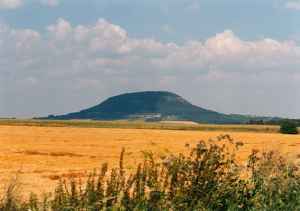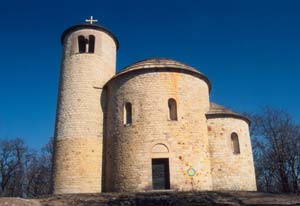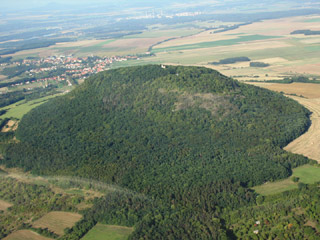Říp Mountain

There is a place in Bohemia – Europe, which has been connected with national identity since time immemorial. Its other dimension, probably the major one, less known however, represents a milestone of the earth lines. Říp as such had existed long before the first man showed up in the Czech Basin.
It had witnessed primeval rivers changing their courses which, in the end, have formed a cross.
It had arisen as an island from a lake a long time ago. Far beyond the ages, this area had been hit by a meteorite – possible main creator of this country relief with a circle of bordering mountains. Even the ancient menhir fields, located within all the directions, have been drawing attention to Říp. Yes, the ancestors had understood the genius loci of this place. Thus, it is a massive central keystone, heart of the architecture of the continental landscape energy centres. It is the heart of Europe. This “stone” order is part of a creative force which can be seen in everything that exists. No matter if it is an imperceptible atom or majestic Universe. Each period carries its own locations of science, culture as well as spirit.
Throughout history, mysterious mythical Říp has always served solely as a spiritual place. We may view a large part of the Czech basin from its peak. It is an energy centre of the menhir fields. Its history deserves its own chapter. Maybe just out of interest: on the peak there are also significant physical anomalies. With each step, the compass needle changes its direction. At the same time mobile phones and transmitters often do not work here properly.
History:
 Říp (460.7 m) – is a basalt mound – considerably lowered due to erosion at present, a volcano remain, an exposed remnant of the Tertiary volcano chimney with huge scree-layers on the foothill. Local sodalite-nepheline basalt contains olivine, magnetite and other minerals.
Říp (460.7 m) – is a basalt mound – considerably lowered due to erosion at present, a volcano remain, an exposed remnant of the Tertiary volcano chimney with huge scree-layers on the foothill. Local sodalite-nepheline basalt contains olivine, magnetite and other minerals.
Říp was forestless until 1875; today almost all of the mountain is covered by forest - mostly oak and hornbeam, nevertheless, other tree-species are found here too.
Říp dominates the Elbe riverside. It is basically 200 metres taller than the countryside surface, and so it is an important landmark that cannot be overseen even from tens of kilometres away. In addition to the unusual bell shape and strategic position among the Elbe, Vltava and Ohře Rivers, it is actually situated in the very heart of Bohemia and since ancient times this eye-catching hill has attracted people's attention. The name Říp is Indo-European – its origin dates back to the Bronze age, and means Mountain. Czech Slavs adopted it from their predecessors.
The legend, recorded by the chronicler Kosmas at the beginning of the 12th century, regards Říp Mountain specifically and its surroundings as a place where the first Slavs had settled.
Later the land was newly named and the new name being derived from the leader of these Slavs – Čech (Czech in English, Bohemus in Latin). The mountain had been located just in the centre of the contemporary Slavic settlement of Bohemia, and the horizon which can been seen from its peak, had concurrently constituted the border of this settlement. In the 16th century Václav Hájek of Libočany had elaborated on a legend of Forefather Čech, so had Alois Jirásek in Staré pověsti české (Ancient Bohemian Legends) in 1894. On the summit of the mountain there is a romanesque rotunda of Saint Jiří (Saint George), originally dedicated to Saint Vojtěch. In memory of the victorious Battle of Chlumec, Duke Soběslav had the existing chapel renovated and extended by adding the western round tower in 1126. That is on the place of the former temple which had undoubtedly been wooden. The chapel was built to precision – there was no other building material used but stone. The walls are made of marlstone ashlar and the roofing also comprises of stone slabs.
The rotunda is divided into three parts. The shape of the middle one is circular, on the Eastern side there is a semi-circular apse connected to the aisle, and a thin cylindrical tower is situated on the North side. There are two bells hanging in the tower; one bell casted in 1509, is the work of the Master of Litoměřice - Tomáš, the second one being almost the same size, originated in 1491. The oldest reference to Saint George dedication is dated to the beginning of the 16th century. At the time the rotunda had served as a parish church for the nearby village of Rovné and in the 18th century it had even been surrounded by a graveyard. Today the State Monument of the Czech Republic, Saint George and the Dragon sculpture by B. Seeling from 1870 are found here, together with the Shepherd statue by the current artist S. Hanzlík which symbolizes the legendary arrival of the Czechs. Inside the stone columns, soils from memorial battles are kept; they are from the Battle of Chlumec, the Hussite Battle of Ústí, the Battle of Dukla and the National Suffering Memorial in Terezín. Arrows carved in the flagstone, show the direction of a compass needle – these indicate the deviation caused by the above mentioned magnetite.
In the 17th and 18th century Říp became a popular place of pilgrimage. Our people used to come to the mountain during difficult and dark times. Since the 19th century Říp has, on many occasions, been a venue of mass meetings and national manifestations. In 1848 a meeting of Prague students was organized here, also joined by the people living in the Říp region and its neighbourhood. Another one of the best known meetings took place on the 10th May 1868, on the occasion of the ceremonial lifting of the first foundation stone for the National Theatre. Furthermore, on the 10th November 1918 people were celebrating the end of World War I and the foundation of our country.
A notable demonstration was also represented by the first pilgrimage to Říp during the German occupation in April 1939. On the 6th July 1945, after the war, our people met here again in order to celebrate the end of World War II. The whole zone of Říp was declared a National Cultural Monument in 1962.
The current shape of the rotunda is a result of reconstruction in the 1870s, adding the southern portal and the larger arc-shaped windows. In the 20th century other renovations in the neo-Romanesque style were carried out. The next restoration of the rotunda exterior was realized in 2009.
This memorable mountain became an inspiration for many artists. Thanks to its imaginativeness, poets such as Jan Neruda and Svatopluk Čech created some of their works. Also the painters Josef Mánes, Mikoláš Aleš or Max Švabinský glorified its beauty in their pieces.
Říp has got a strategic location thanks to its positioning among the Elbe, Vltava and Ohře Rivers. It is situated close to the town of Roudnice nad Labem and geographically falls within the Ústí Region Area. There are several marked tourist trails leading to the summit. The observation points are popular as well: approximately in the middle of the journey from the parking lot there is the Mělník Observation Point. The Mělník Observation Point encompasses destinations including the villages just below Říp – Rovné, Krabčice, Kostomlaty, on the right hand side the town of Mělník, Bezděz Mountain approximately in the middle, Ještěd Mountain during high visibility, and Krkonoše (Giant) Mountains together with Sněžka Mountain may be seen several times a year. Taking the path behind the rotunda you will reach a spot where the foundation stone for the National Theatre was taken, it is about 200 meters far; in about 20 meters further to the left you will reach the observation point from where you can see the whole panorama of the hills of the České středohoří (Bohemian Central Uplands). Taking the red and yellow tourist trails behind the restaurant you will get to the Prague Observation Point in about 100 meters. From the larger towns, Kladno, Kralupy Neratovice and again Mělník can be seen, and beyond those, the city of Prague during high visibility.
As for Prague, one may catch the sight of the St. Vitus Cathedral, Hradčany (the Prague Castle area), Petřín Hill, Bílá (White) Mountain, Strahov (district of Prague) and others. Further on the right there is a view of hills by the town of Louny, and if weather allows, the town of Most and the Krušné (Ore) Mountains. It is possible to get a view of more or less one third of Bohemia from Říp.
Thus, we have a possibility to stop on this hill not so high in its altitude but all the greater in importance - not only for this region, but within the larger and larger wholes it is also an important energy centre of the planetary energy centres.
This has already been known by our ancestors who used to go there centuries ago.  |


 Říp (460.7 m) – is a basalt mound – considerably lowered due to erosion at present, a volcano remain, an exposed remnant of the Tertiary volcano chimney with huge scree-layers on the foothill. Local sodalite-nepheline basalt contains olivine, magnetite and other minerals.
Říp (460.7 m) – is a basalt mound – considerably lowered due to erosion at present, a volcano remain, an exposed remnant of the Tertiary volcano chimney with huge scree-layers on the foothill. Local sodalite-nepheline basalt contains olivine, magnetite and other minerals.
